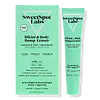What's inside
What's inside
 Key Ingredients
Key Ingredients

 Benefits
Benefits

 Concerns
Concerns

 Ingredients Side-by-side
Ingredients Side-by-side

Water
Skin ConditioningAzelaic Acid
BufferingButylene Glycol
HumectantDipropylene Glycol
Humectant1,2-Hexanediol
Skin ConditioningPropanediol
SolventCaprylic/Capric Triglyceride
MaskingPanthenol
Skin ConditioningCetyl Ethylhexanoate
EmollientButylene Glycol Dicaprylate/Dicaprate
EmollientSpirulina Platensis Extract
Skin ProtectingRhodomyrtus Tomentosa Fruit Extract
HumectantArtemisia Vulgaris Extract
Skin ConditioningCentella Asiatica Extract
CleansingSpinacia Oleracea Leaf Extract
Skin ConditioningBrassica Oleracea Italica Extract
AstringentTapioca Starch
Allantoin
Skin ConditioningBetaine
HumectantSodium Polyacryloyldimethyl Taurate
Emulsion StabilisingArginine
MaskingEthylhexyl Palmitate
EmollientSorbitan Isostearate
EmulsifyingAcrylates/C10-30 Alkyl Acrylate Crosspolymer
Emulsion StabilisingDextrin
AbsorbentCarthamus Tinctorius Flower Extract
Skin ConditioningGardenia Florida Fruit Extract
Skin ConditioningPolyacrylate-13
Hydrogenated Polyisobutene
EmollientPolyglyceryl-10 Laurate
Skin ConditioningCaprylyl Glycol
EmollientWater, Azelaic Acid, Butylene Glycol, Dipropylene Glycol, 1,2-Hexanediol, Propanediol, Caprylic/Capric Triglyceride, Panthenol, Cetyl Ethylhexanoate, Butylene Glycol Dicaprylate/Dicaprate, Spirulina Platensis Extract, Rhodomyrtus Tomentosa Fruit Extract, Artemisia Vulgaris Extract, Centella Asiatica Extract, Spinacia Oleracea Leaf Extract, Brassica Oleracea Italica Extract, Tapioca Starch, Allantoin, Betaine, Sodium Polyacryloyldimethyl Taurate, Arginine, Ethylhexyl Palmitate, Sorbitan Isostearate, Acrylates/C10-30 Alkyl Acrylate Crosspolymer, Dextrin, Carthamus Tinctorius Flower Extract, Gardenia Florida Fruit Extract, Polyacrylate-13, Hydrogenated Polyisobutene, Polyglyceryl-10 Laurate, Caprylyl Glycol
Water
Skin ConditioningKaolin
AbrasiveCaprylic/Capric Triglyceride
MaskingPropanediol
SolventArachidyl Glucoside
EmulsifyingAzelaic Acid
BufferingStearyl Alcohol
EmollientBentonite
AbsorbentSalicylic Acid
MaskingNiacinamide
SmoothingGlycyrrhiza Glabra Root Extract
BleachingCamellia Sinensis Leaf Extract
AntimicrobialCamellia Sinensis Seed Extract
HumectantStearyl Glycyrrhetinate
Skin ConditioningChlorophyllin-Copper Complex
AntioxidantCitric Acid
BufferingAmylopectin
Dextrin
AbsorbentPolydextrose
HumectantSodium Hydroxide
BufferingPotassium Cetyl Phosphate
EmulsifyingXanthan Gum
EmulsifyingEthylhexylglycerin
Skin ConditioningPotassium Sorbate
PreservativePhenoxyethanol
PreservativeArachidyl Alcohol
EmollientBehenyl Alcohol
EmollientZinc PCA
HumectantWater, Kaolin, Caprylic/Capric Triglyceride, Propanediol, Arachidyl Glucoside, Azelaic Acid, Stearyl Alcohol, Bentonite, Salicylic Acid, Niacinamide, Glycyrrhiza Glabra Root Extract, Camellia Sinensis Leaf Extract, Camellia Sinensis Seed Extract, Stearyl Glycyrrhetinate, Chlorophyllin-Copper Complex, Citric Acid, Amylopectin, Dextrin, Polydextrose, Sodium Hydroxide, Potassium Cetyl Phosphate, Xanthan Gum, Ethylhexylglycerin, Potassium Sorbate, Phenoxyethanol, Arachidyl Alcohol, Behenyl Alcohol, Zinc PCA
 Reviews
Reviews

Ingredients Explained
These ingredients are found in both products.
Ingredients higher up in an ingredient list are typically present in a larger amount.
Azelaic acid is a multitasker ingredient that helps treat acne, pigmentation, and irritation. It is a great option for sensitive skin.
What makes azelaic special?
The best thing about azelaic acid is it's gentleness. It's generally well-tolerated and safe to use alongside other actives like niacinamide or salicylic acid.
Unlike AHAs, azelaic acid will not make you photosensitive/sun sensitive.
You can find this ingredient naturally occurring in grains like wheat, rye, and barley. In cosmetics, azelaic acid is typically lab-made, which is more stable and effective.
Learn more about Azelaic AcidThis ingredient is an emollient, solvent, and texture enhancer. It is considered a skin-softener by helping the skin prevent moisture loss.
It helps thicken a product's formula and makes it easier to spread by dissolving clumping compounds.
Caprylic Triglyceride is made by combining glycerin with coconut oil, forming a clear liquid.
While there is an assumption Caprylic Triglyceride can clog pores due to it being derived from coconut oil, there is no research supporting this.
Learn more about Caprylic/Capric TriglycerideDextrin is used to thicken a product and helps bind ingredients together. It is created from starch and glycogen.
As an emulsifier, dextrin prevents ingredients from separating. This helps elongate a product's shelf life.
Studies show coating UV filters with dextrin prevents these ingredients from being absorbed. This helps UV ingredients last longer on the skin.
Learn more about DextrinPropanediol is an all-star ingredient. It softens, hydrates, and smooths the skin.
It’s often used to:
Propanediol is not likely to cause sensitivity and considered safe to use. It is derived from corn or petroleum with a clear color and no scent.
Learn more about PropanediolWater. It's the most common cosmetic ingredient of all. You'll usually see it at the top of ingredient lists, meaning that it makes up the largest part of the product.
So why is it so popular? Water most often acts as a solvent - this means that it helps dissolve other ingredients into the formulation.
You'll also recognize water as that liquid we all need to stay alive. If you see this, drink a glass of water. Stay hydrated!
Learn more about Water